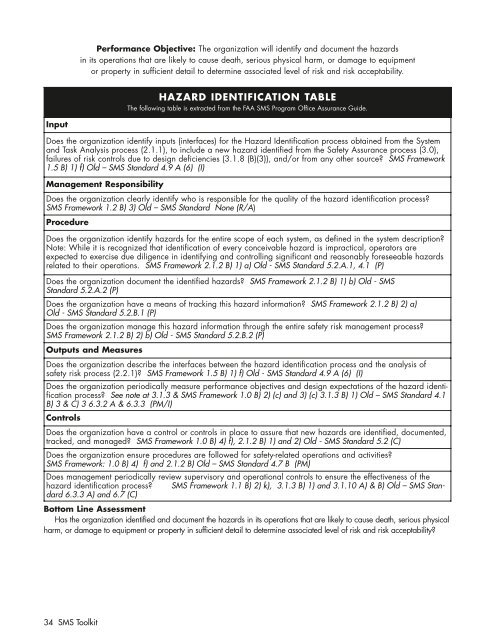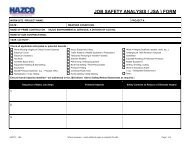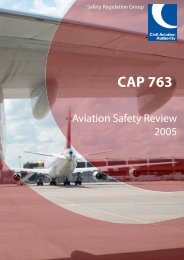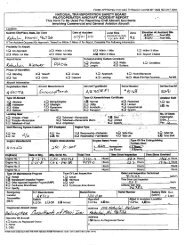International Helicopter Safety Team Safety Management System Toolkit
IHST - Safety Management Toolkit - Skybrary
IHST - Safety Management Toolkit - Skybrary
- No tags were found...
You also want an ePaper? Increase the reach of your titles
YUMPU automatically turns print PDFs into web optimized ePapers that Google loves.
Performance Objective: The organization will identify and document the hazards<br />
in its operations that are likely to cause death, serious physical harm, or damage to equipment<br />
or property in sufficient detail to determine associated level of risk and risk acceptability.<br />
HAZARD IDENTIFICATION TABLE<br />
The following table is extracted from the FAA SMS Program Office Assurance Guide.<br />
Input<br />
Does the organization identify inputs (interfaces) for the Hazard Identification process obtained from the <strong>System</strong><br />
and Task Analysis process (2.1.1), to include a new hazard identified from the <strong>Safety</strong> Assurance process (3.0),<br />
failures of risk controls due to design deficiencies (3.1.8 (B)(3)), and/or from any other source? SMS Framework<br />
1.5 B) 1) f) Old – SMS Standard 4.9 A (6) (I)<br />
<strong>Management</strong> Responsibility<br />
Does the organization clearly identify who is responsible for the quality of the hazard identification process?<br />
SMS Framework 1.2 B) 3) Old – SMS Standard None (R/A)<br />
Procedure<br />
Does the organization identify hazards for the entire scope of each system, as defined in the system description?<br />
Note: While it is recognized that identification of every conceivable hazard is impractical, operators are<br />
expected to exercise due diligence in identifying and controlling significant and reasonably foreseeable hazards<br />
related to their operations. SMS Framework 2.1.2 B) 1) a) Old - SMS Standard 5.2.A.1, 4.1 (P)<br />
Does the organization document the identified hazards? SMS Framework 2.1.2 B) 1) b) Old - SMS<br />
Standard 5.2.A.2 (P)<br />
Does the organization have a means of tracking this hazard information? SMS Framework 2.1.2 B) 2) a)<br />
Old - SMS Standard 5.2.B.1 (P)<br />
Does the organization manage this hazard information through the entire safety risk management process?<br />
SMS Framework 2.1.2 B) 2) b) Old - SMS Standard 5.2.B.2 (P)<br />
Outputs and Measures<br />
Does the organization describe the interfaces between the hazard identification process and the analysis of<br />
safety risk process (2.2.1)? SMS Framework 1.5 B) 1) f) Old - SMS Standard 4.9 A (6) (I)<br />
Does the organization periodically measure performance objectives and design expectations of the hazard identification<br />
process? See note at 3.1.3 & SMS Framework 1.0 B) 2) (c) and 3) (c) 3.1.3 B) 1) Old – SMS Standard 4.1<br />
B) 3 & C) 3 6.3.2 A & 6.3.3 (PM/I)<br />
Controls<br />
Does the organization have a control or controls in place to assure that new hazards are identified, documented,<br />
tracked, and managed? SMS Framework 1.0 B) 4) f), 2.1.2 B) 1) and 2) Old - SMS Standard 5.2 (C)<br />
Does the organization ensure procedures are followed for safety-related operations and activities?<br />
SMS Framework: 1.0 B) 4) f) and 2.1.2 B) Old – SMS Standard 4.7 B (PM)<br />
Does management periodically review supervisory and operational controls to ensure the effectiveness of the<br />
hazard identification process? SMS Framework 1.1 B) 2) k), 3.1.3 B) 1) and 3.1.10 A) & B) Old – SMS Standard<br />
6.3.3 A) and 6.7 (C)<br />
Bottom Line Assessment<br />
Has the organization identified and document the hazards in its operations that are likely to cause death, serious physical<br />
harm, or damage to equipment or property in sufficient detail to determine associated level of risk and risk acceptability?<br />
34 SMS <strong>Toolkit</strong>







